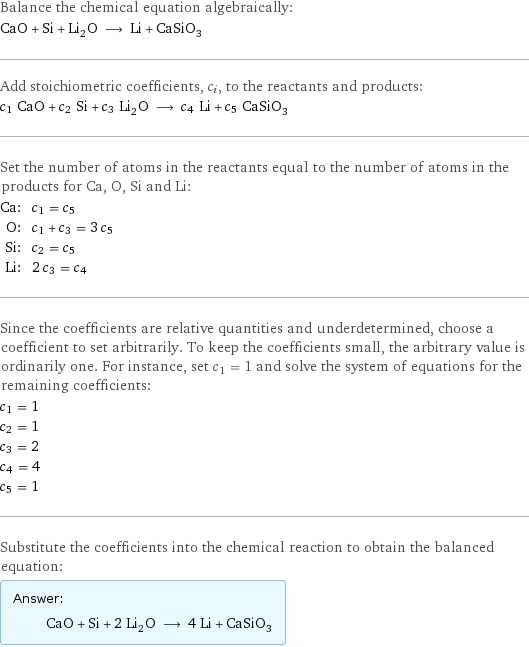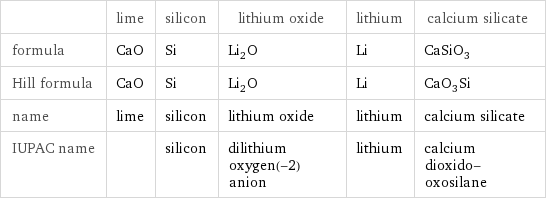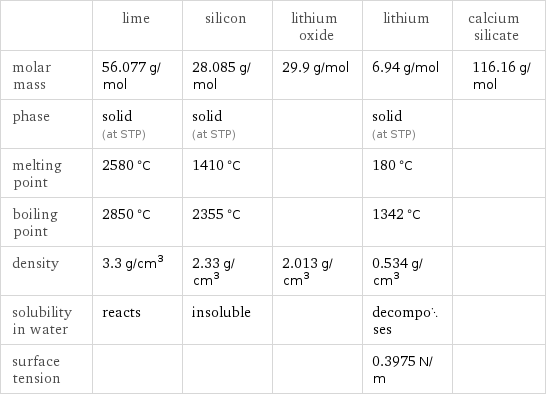Input interpretation

CaO lime + Si silicon + Li_2O lithium oxide ⟶ Li lithium + CaSiO_3 calcium silicate
Balanced equation

Balance the chemical equation algebraically: CaO + Si + Li_2O ⟶ Li + CaSiO_3 Add stoichiometric coefficients, c_i, to the reactants and products: c_1 CaO + c_2 Si + c_3 Li_2O ⟶ c_4 Li + c_5 CaSiO_3 Set the number of atoms in the reactants equal to the number of atoms in the products for Ca, O, Si and Li: Ca: | c_1 = c_5 O: | c_1 + c_3 = 3 c_5 Si: | c_2 = c_5 Li: | 2 c_3 = c_4 Since the coefficients are relative quantities and underdetermined, choose a coefficient to set arbitrarily. To keep the coefficients small, the arbitrary value is ordinarily one. For instance, set c_1 = 1 and solve the system of equations for the remaining coefficients: c_1 = 1 c_2 = 1 c_3 = 2 c_4 = 4 c_5 = 1 Substitute the coefficients into the chemical reaction to obtain the balanced equation: Answer: | | CaO + Si + 2 Li_2O ⟶ 4 Li + CaSiO_3
Structures

+ + ⟶ +
Names

lime + silicon + lithium oxide ⟶ lithium + calcium silicate
Equilibrium constant
![Construct the equilibrium constant, K, expression for: CaO + Si + Li_2O ⟶ Li + CaSiO_3 Plan: • Balance the chemical equation. • Determine the stoichiometric numbers. • Assemble the activity expression for each chemical species. • Use the activity expressions to build the equilibrium constant expression. Write the balanced chemical equation: CaO + Si + 2 Li_2O ⟶ 4 Li + CaSiO_3 Assign stoichiometric numbers, ν_i, using the stoichiometric coefficients, c_i, from the balanced chemical equation in the following manner: ν_i = -c_i for reactants and ν_i = c_i for products: chemical species | c_i | ν_i CaO | 1 | -1 Si | 1 | -1 Li_2O | 2 | -2 Li | 4 | 4 CaSiO_3 | 1 | 1 Assemble the activity expressions accounting for the state of matter and ν_i: chemical species | c_i | ν_i | activity expression CaO | 1 | -1 | ([CaO])^(-1) Si | 1 | -1 | ([Si])^(-1) Li_2O | 2 | -2 | ([Li2O])^(-2) Li | 4 | 4 | ([Li])^4 CaSiO_3 | 1 | 1 | [CaSiO3] The equilibrium constant symbol in the concentration basis is: K_c Mulitply the activity expressions to arrive at the K_c expression: Answer: | | K_c = ([CaO])^(-1) ([Si])^(-1) ([Li2O])^(-2) ([Li])^4 [CaSiO3] = (([Li])^4 [CaSiO3])/([CaO] [Si] ([Li2O])^2)](../image_source/b3cb7747031e1ad6cad7ec3446206aba.png)
Construct the equilibrium constant, K, expression for: CaO + Si + Li_2O ⟶ Li + CaSiO_3 Plan: • Balance the chemical equation. • Determine the stoichiometric numbers. • Assemble the activity expression for each chemical species. • Use the activity expressions to build the equilibrium constant expression. Write the balanced chemical equation: CaO + Si + 2 Li_2O ⟶ 4 Li + CaSiO_3 Assign stoichiometric numbers, ν_i, using the stoichiometric coefficients, c_i, from the balanced chemical equation in the following manner: ν_i = -c_i for reactants and ν_i = c_i for products: chemical species | c_i | ν_i CaO | 1 | -1 Si | 1 | -1 Li_2O | 2 | -2 Li | 4 | 4 CaSiO_3 | 1 | 1 Assemble the activity expressions accounting for the state of matter and ν_i: chemical species | c_i | ν_i | activity expression CaO | 1 | -1 | ([CaO])^(-1) Si | 1 | -1 | ([Si])^(-1) Li_2O | 2 | -2 | ([Li2O])^(-2) Li | 4 | 4 | ([Li])^4 CaSiO_3 | 1 | 1 | [CaSiO3] The equilibrium constant symbol in the concentration basis is: K_c Mulitply the activity expressions to arrive at the K_c expression: Answer: | | K_c = ([CaO])^(-1) ([Si])^(-1) ([Li2O])^(-2) ([Li])^4 [CaSiO3] = (([Li])^4 [CaSiO3])/([CaO] [Si] ([Li2O])^2)
Rate of reaction
![Construct the rate of reaction expression for: CaO + Si + Li_2O ⟶ Li + CaSiO_3 Plan: • Balance the chemical equation. • Determine the stoichiometric numbers. • Assemble the rate term for each chemical species. • Write the rate of reaction expression. Write the balanced chemical equation: CaO + Si + 2 Li_2O ⟶ 4 Li + CaSiO_3 Assign stoichiometric numbers, ν_i, using the stoichiometric coefficients, c_i, from the balanced chemical equation in the following manner: ν_i = -c_i for reactants and ν_i = c_i for products: chemical species | c_i | ν_i CaO | 1 | -1 Si | 1 | -1 Li_2O | 2 | -2 Li | 4 | 4 CaSiO_3 | 1 | 1 The rate term for each chemical species, B_i, is 1/ν_i(Δ[B_i])/(Δt) where [B_i] is the amount concentration and t is time: chemical species | c_i | ν_i | rate term CaO | 1 | -1 | -(Δ[CaO])/(Δt) Si | 1 | -1 | -(Δ[Si])/(Δt) Li_2O | 2 | -2 | -1/2 (Δ[Li2O])/(Δt) Li | 4 | 4 | 1/4 (Δ[Li])/(Δt) CaSiO_3 | 1 | 1 | (Δ[CaSiO3])/(Δt) (for infinitesimal rate of change, replace Δ with d) Set the rate terms equal to each other to arrive at the rate expression: Answer: | | rate = -(Δ[CaO])/(Δt) = -(Δ[Si])/(Δt) = -1/2 (Δ[Li2O])/(Δt) = 1/4 (Δ[Li])/(Δt) = (Δ[CaSiO3])/(Δt) (assuming constant volume and no accumulation of intermediates or side products)](../image_source/a7048d18cbddbd56889b63e79831ed4a.png)
Construct the rate of reaction expression for: CaO + Si + Li_2O ⟶ Li + CaSiO_3 Plan: • Balance the chemical equation. • Determine the stoichiometric numbers. • Assemble the rate term for each chemical species. • Write the rate of reaction expression. Write the balanced chemical equation: CaO + Si + 2 Li_2O ⟶ 4 Li + CaSiO_3 Assign stoichiometric numbers, ν_i, using the stoichiometric coefficients, c_i, from the balanced chemical equation in the following manner: ν_i = -c_i for reactants and ν_i = c_i for products: chemical species | c_i | ν_i CaO | 1 | -1 Si | 1 | -1 Li_2O | 2 | -2 Li | 4 | 4 CaSiO_3 | 1 | 1 The rate term for each chemical species, B_i, is 1/ν_i(Δ[B_i])/(Δt) where [B_i] is the amount concentration and t is time: chemical species | c_i | ν_i | rate term CaO | 1 | -1 | -(Δ[CaO])/(Δt) Si | 1 | -1 | -(Δ[Si])/(Δt) Li_2O | 2 | -2 | -1/2 (Δ[Li2O])/(Δt) Li | 4 | 4 | 1/4 (Δ[Li])/(Δt) CaSiO_3 | 1 | 1 | (Δ[CaSiO3])/(Δt) (for infinitesimal rate of change, replace Δ with d) Set the rate terms equal to each other to arrive at the rate expression: Answer: | | rate = -(Δ[CaO])/(Δt) = -(Δ[Si])/(Δt) = -1/2 (Δ[Li2O])/(Δt) = 1/4 (Δ[Li])/(Δt) = (Δ[CaSiO3])/(Δt) (assuming constant volume and no accumulation of intermediates or side products)
Chemical names and formulas

| lime | silicon | lithium oxide | lithium | calcium silicate formula | CaO | Si | Li_2O | Li | CaSiO_3 Hill formula | CaO | Si | Li_2O | Li | CaO_3Si name | lime | silicon | lithium oxide | lithium | calcium silicate IUPAC name | | silicon | dilithium oxygen(-2) anion | lithium | calcium dioxido-oxosilane
Substance properties

| lime | silicon | lithium oxide | lithium | calcium silicate molar mass | 56.077 g/mol | 28.085 g/mol | 29.9 g/mol | 6.94 g/mol | 116.16 g/mol phase | solid (at STP) | solid (at STP) | | solid (at STP) | melting point | 2580 °C | 1410 °C | | 180 °C | boiling point | 2850 °C | 2355 °C | | 1342 °C | density | 3.3 g/cm^3 | 2.33 g/cm^3 | 2.013 g/cm^3 | 0.534 g/cm^3 | solubility in water | reacts | insoluble | | decomposes | surface tension | | | | 0.3975 N/m |
Units
